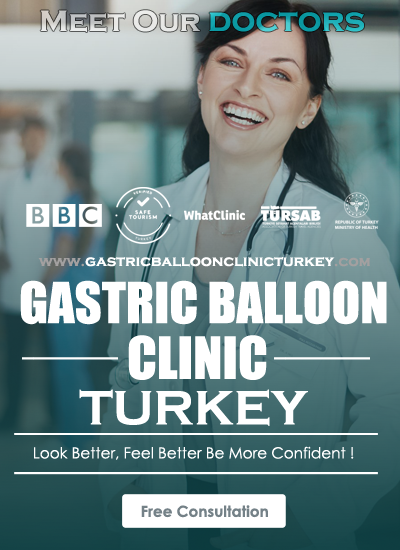Health Travel Obesity Center Antalya Turkey
Calculate Your Cost / Price
Obesity Center Antalya
Gastric Balloon in Antalya / Turkey
-
What is a Gastric Balloon?
-
1.1 Technical Details
-
1.2 Is the Gastric Balloon a New Method?
-
1.3 What is the Difference Between a Swallowable Gastric Balloon and a Regular Gastric Balloon?
-
1.4 How is a Gastric Balloon Inserted?
-
1.5 How is a Gastric Balloon Removed?
-
1.6 Gastric Balloon Prices in 2024
-
2 For Whom, Why, and When is a Gastric Balloon Applied?
-
2.1 Who is Suitable for a Gastric Balloon?
-
2.2 Who is Not Suitable for a Gastric Balloon?
-
3 Risks and Complications of the Gastric Balloon
-
3.1 What Happens if the Gastric Balloon Bursts?
-
4 What are the Outcomes of Gastric Balloon Application?
-
5 After the Gastric Balloon
-
5.1 Nutrition After the Gastric Balloon
-
5.2 Physical Activity Orientation
-
5.3 Psychological Support
-
6.1 How Does the Gastric Balloon Help with Weight Loss?
-
6.2 What is the Purpose of the Gastric Balloon?
-
6.3 Are People Satisfied with the Gastric Balloon?
-
6.4 What are the Advantages of the Gastric Balloon?
-
6.5 What are the Risks / Disadvantages of the Gastric Balloon?
- 6.6.1 Sources
International Journal of Obesity
Journal of Bariatric Surgery
In cases where diet and exercise do not yield results in obese patients or when rapid weight loss is necessary for health reasons, surgical and non-surgical treatment options are utilized. Gastric balloon is one of the non-surgical methods for gastric reduction. Gastric balloon is widely preferred by patients and experts in recent years due to its ability to assist in rapid weight loss and its non-surgical application.
Gastric Balloon Prices in Antalya / Turkey
Gastric Balloon can change your life by providing quick and effective weight loss while reducing obesity-related health problems.
Gastric Balloon is one of the most popular weight loss methods in recent years. This method is designed to overcome the challenges encountered in weight loss journeys, as well as health problems associated with obesity. When used in conjunction with diet and exercise, Gastric Balloon provides a permanent weight loss and helps you take a step towards a healthier lifestyle.
Preparing for Your Allurion Elipse Gastric Balloon
In the weeks leading up to the procedure, it is a great time to make changes in your eating habits to ensure that you are ready to use the balloon. These changes also include starting to eat more mindfully:
► Plan your meals and snacks in advance, as well as your eating times.
► Try to eat sitting down and focus on your meal.
► Eat your meals slowly and chew thoroughly.
► Separate your food and drink by taking small sips only before and after a meal.
► Stop eating as soon as you start feeling full.
If you have a smartphone, download our mobile application, the Allurion Mobile App. This application will be synchronized with the Allurion Smart Scale and Allurion Smart Watch provided to you at the clinic to track your progress.
Under the guidance of your doctor, start taking antacids two weeks before the application date and take the anti-nausea medication prescribed by your clinic (usually the night before and the morning of the application).
In the 24-48 hours before the placement of the balloon, aim to consume at least 2 liters of liquid spread throughout the day and make sure you are well-hydrated.
Restrict your fluid intake to clear fluids only for approximately 10-12 hours leading up to the application. You will be asked to stop fluid intake 2 hours before the application.
Sample Meal Plan:
BREAKFAST
125 ml (1/2 cup) milk or protein shake
SNACK
125 ml (1/2 cup) plain yogurt/high-protein yogurt (low-fat Turkish yogurt)
LUNCH
Blended 2 tablespoons of chicken/red meat/fish or 2 tablespoons of vegetable puree or high-protein blended soup
AFTERNOON SNACK
1/2 cup homogenized yogurt or high-protein yogurt/protein shake
DINNER
Blended 2 tablespoons of fish/chicken/red meat + 2 tablespoons of mashed potatoes or blended lentil soup. Have dinner at 7:00 PM and avoid consuming excessive fluids afterwards.
Good protein shakes should contain approximately 15 to 20 grams of protein, maximum 200 calories, and 10 grams of sugar. You can also add unflavored protein powder to your homemade soups or shakes.
Other recommendations:
► Fat-free dairy products without fruit pieces (milk, yogurt).
► Sugar-free gelatin/pudding and cream (low-fat milk).
► Sugar-free herbal tea, green tea, chamomile, anise (you can add low-fat milk).
► Low-fat spreadable cheese or cottage cheese.
► Soups (blended). You can add vegetables, potatoes, red meat, chicken, lentils, etc.
► Low-fat protein shakes (vanilla, chocolate, or strawberry).
► Oatmeal cooked with skim milk.
Stage 3 - Soft Food Diet (Days 3-5)
If you can tolerate liquids and purees well, you can start trying soft foods. Remember to keep portion sizes small, take small bites, and chew each bite thoroughly. If you notice that soft foods worsen your nausea and vomiting, return to a liquid diet for 24 hours before trying them again.
Guidelines:
► The soft food diet consists of easily chewed and swallowed soft foods. These foods can be chopped, blended, mashed, pureed, or soaked.
► Use measuring cups to help you with portion sizes.
► Chew your food thoroughly, eat slowly, and stop eating or drinking when you feel the first signs of fullness.
Sample Meal Plan:
BREAKFAST
125 ml (1/2 cup) low-fat milk + 15 grams of sugar-coated cereal/porridge/2 dry biscuits
SNACK
Fruit puree or natural yogurt - 125 ml (1/2 cup) or protein shake
LUNCH
Scrambled eggs (x1-2) + 2 tablespoons of vegetable puree or 1 cup of chunky chicken soup or steamed white fish or 1 cup of dried beans or lentils
AFTERNOON SNACK
125 ml (1/2 cup) plain yogurt and a handful of soft fruits
DINNER
2 tablespoons of low-fat cheese + 2 tablespoons of mashed potatoes or bolognese and zucchini pasta or light curry with meat and vegetables
Other important points:
► The total fat intake should not exceed 20 grams per day during this stage.
► Diets may vary during this stage. Your nutritionist will guide you throughout this phase.
Stage 4 - Return to Solid Food Diet (Days 5-7)
Most people return to their normal solid food meals after the 5-7 day period. However, for some individuals, this process may take up to 2 weeks. If you experience only stomach cramps without nausea or vomiting, they are usually hunger pangs that can be alleviated by consuming more solid or semi-solid foods.
After transitioning to solid foods, try to establish a rhythm of 3 meals per day and allow your body and balloon to determine if planned snacks are necessary. However, it is generally recommended to include small and healthy snacks in your diet to maintain a stable sugar level. The key to sustaining these changes in the long term is to establish a regular routine.
Make sure to work closely with your guidance team to find the most suitable routine for you.
Other important points:
► During the first month, avoiding leafy vegetables may be helpful.
► Ensure you are getting enough fluids.
Months 1-3
Tips for eating well and feeling good
► Eat your meals slowly and chew each bite thoroughly. Take a break between bites to evaluate the fullness sensation (feeling satisfied) in your chest.
► Avoid consuming liquids with meals. Take sips before and after.
► Transition from 3 balanced meals to 2 small snacks and 3 balanced meals.
► Consider taking an A-2 multivitamin and mineral supplement during the Allurion Program to protect against nutritional deficiencies.
► Stop eating if you experience reflux (heartburn), gas, bloating, or belching. Avoid smoking before meals.
► Avoid consuming excessive alcohol, carbonated beverages, highly caffeinated drinks, or high-calorie beverages.
► Avoid eating dinner too late in the evening. Avoid lying down immediately after eating and wait at least two to three hours before bedtime.
► You may experience some discomfort when trying to sleep or lying on your side. Supporting your body with pillows can reduce discomfort.
► Sleeping on your left side is more suitable and can reduce balloon-related symptoms during the night.
► Make an effort to be physically active for at least 30 minutes per day. Consult your guide to find the type of activity that suits you and your lifestyle.
► Ensure you regularly share your updated weight information with your guidance team at least once a week to receive continuous monitoring and support. These services are included in your package and are crucial for your success.
► Use small plates to help with portion control.

Meeting Protein Needs
During weight loss, high protein intake can help preserve our lean body mass consisting of muscles and bones, which support our metabolism and overall health.
Your care team will assist you in determining the appropriate protein intake level for you. The correct level will typically be 1 to 1.5 grams per kilogram of ideal body weight, depending on your health history, current lifestyle, and exercise levels. Your nutritionist can help you with this calculation.
Stage 3
4th Month and Beyond
Maintaining weight loss and optimizing results in the fourth month
After the first 2-3 months, some individuals may start to notice that they have become accustomed to the presence of the balloon and its effects may be less noticeable. As with any weight loss journey, the Allurion weight loss journey can also plateau after the initial months. If your weight loss has stalled, there may be combination treatments to consider. These may include medications, fiber supplements, or more structured diets (e.g., very low-calorie ketogenic diet or intermittent fasting) and exercise programs. Consult your guidance team to discuss suitable options.
Balloon Removal
The balloon deflates around the 16th week and passes out of your system. However, the time for the balloon to pass out of your body can take between 3 to 5 months or longer. During this process, you may experience some stomach cramping and diarrhea. Returning to a soft food diet for one week from the 15th week can help alleviate these side effects. Most patients may not see the empty balloon being expelled naturally. In rare cases, a small percentage of patients may vomit and expel the empty balloon. While it may sound alarming, no adverse events have been reported concerning the expulsion of the balloon in this manner. If this occurs, no additional intervention or further follow-up is typically required.
Starting Your Life Confidently After the Balloon
It is normal to feel anxious or apprehensive about whether you cancontinue your success after the balloon is expelled. Consult with your guide and establish a plan to follow for a few weeks until you feel more confident. The key is to maintain the structure and routine that you have perfected over the past few months, including the same food choices, portion sizes, meal frequency, and exercise routine. By doing so, you can continue your success and maintain your weight loss. Your guidance team will be there to support you during this transition period.
Allurion Assurance Plus Guarantee
Rest assured during the Allurion Program. Participants in the Allurion Program are covered by the Assurance Plus Guarantee without any additional cost after balloon placement.
Guarantee Coverage:
♦ The balloon stays in the stomach for at least 90 days before naturally passing. If it deflates and passes earlier, it will be replaced***.
♦ Reimbursement for out-of-pocket expenses in case of very rare events***.
***Read the full terms and conditions for details: www.allurion.com/en/warranty
Allurion Gastric Balloon Reviews
Overall, our patients express satisfaction with the ease of the procedure, absence of anesthesia requirements, and low complication rates. You can review our page on this topic through this link.
You can access user reviews for the Allurion Swallowable Gastric Balloon here.

FQ About Gastric Balloon Clinic in Antalya / Turkey
Pages
-
£ 1580£ 1450GASTRIC BALLOON PROCEDURE PACKAGE
Give a call to learn more about what’s included and to come up with a tailored plan if you need unique accommodations that are not listed below.
- Airport
- Hotel
- Hospital transfer
- The balloon is placed via endoscopy, the procedure takes 15-20 minutes and you are discharged after 2-3 hours. It is enough to stay here for 1 night.
- Blood samples & x-rays
- 5 year follow up
-
£ 2750£ 2550GASTRIC SLEEVE PACKAGE
GASTRIC SLEEVE PACKAGE COST TURKEY / ANTALYA
Give a call to learn more about what’s included and to come up with a tailored plan if you need unique accommodations that are not listed below.- Airport
- Hotel
- Hospital transfer
- 4 day stay at hospital
- Blood samples & x-rays
- 5 year follow up
-
£ 3100£ 2900MINI GASTRIC BYPASS PACKAGE
MINI GASTRIC BYPASS PACKAGE TURKEY
Give a call to learn more about what’s included and to come up with a tailored plan if you need unique accommodations that are not listed below.- Airport
- Hotel
- Hospital transfer
- 4 day stay at hospital
- Blood samples & x-rays
- 5 year follow up












